Gynecomastia symptoms may make men uncomfortable, which is particularly true if it involves one or both breasts.
As it’s essential to distinguish gynecomastia from pseudogynecomastia (fatty tissue deposits in breasts caused by obesity), only a qualified healthcare provider can diagnose this condition through physical exam.
1. Tenderness
Gynecomastia’s most obvious symptoms include tenderness of breast tissue. It usually begins as an elastic mass under or around your nipple and then spreads across your chest – often favoring one side more than others.
Gynecomastia does not involve fat accumulation; rather, it is often caused by hormonal fluctuations that stimulate breast tissue development. Most cases resolve on their own with no long-term health risks associated with treatment being necessary.
Anabolic steroids, antibiotics, antidepressants, chemotherapy drugs and heart medicines such as those to treat depression, high blood pressure or stomach ulcers may all cause this side effect. Herbal products containing plant estrogens like tea tree or lavender oils found in soaps, shampoos and lotions also can contribute to it, though usually this effect will resolve once you stop using these products. It can also happen as the result of malnourishment or starvation or drug use (heroin or marijuana use in particular).
2. Discomfort
Gynecomastia causes individuals to experience discomfort when touching their breast tissue, with this sensation often more prominent in young boys and children. Gynecomastia should not be confused with fat accumulation seen among overweight individuals as this disorder does not correspond with cancerous growths and most cases will resolve without medical intervention.
Doctors will conduct an exam of your chest to check for hard lumps, fluid leakage or signs of tumor or health issue. Additionally, they may inquire into your history with gynecomastia as well as any medications being taken, which could include antidepressants, heart medicines, antibiotics and cancer drugs; illegal substances like steroids and marijuana may also contribute. Taking certain medicines may worsen symptoms; individuals suffering from gynecomastia may see their symptoms improve by discontinuing some medicines altogether.
3. Swelling
Gynecomastia, or male breast enlargement, can be identified by an increase in breast tissue size that typically takes the shape of a button-sized lump or mammary glands. It typically affects both sides and may feel rubbery or firm depending on which side is affected and can result from an imbalance between testosterone and estrogen; typically occurring during puberty or as men age when less testosterone is produced by their bodies, although newborns may temporarily experience transplacental transfer of maternal estrogen causing temporary gynecomastia; it can also occur due to genetic conditions such as Klinefelter syndrome which includes an extra X chromosome, with both cells carrying one copy.
Medicines that affect hormones may cause gynecomastia; to detect any possible instances, a doctor should review all medications taken by their patient and consider any that might contribute to it as potential sources. Lifestyle habits like drinking alcohol or taking illegal drugs could also contribute to its formation; such substances should be stopped or recommended as alternatives by the physician.
4. Emotional distress
Gynecomastia’s most distinguishing characteristic is an increase in breast tissue size. It can be felt as an enlarged lump beneath and around the nipple, sometimes occurring equally or more prominently on one side of the body; additionally it may be painful or tender when touched.
Symptoms of puberty-related chest conditions can cause emotional trauma for young people. This distress often manifests itself through withdrawal from social activities, feeling embarrassed about their chests and avoiding clothing that highlights it, low self-esteem issues and difficulty discussing the matter with others.
Treatment of Gynecomastia depends on its underlying cause. If it is caused by an imbalance between testosterone and oestrogen hormones, symptoms will typically resolve themselves over time; otherwise, drugs must be discontinued before surgery can take place to remove excess breast tissue.
Disclaimer: The content on this blog is intended for general informational purposes only. It is not a substitute for professional medical advice, diagnosis, or treatment. Always consult qualified healthcare providers for personalized advice. Information regarding plastic surgery, dental treatment, hair transplant, and other medical procedures is educational and not a guarantee of results. We do not assume liability for actions taken based on blog content. Medical knowledge evolves; verify information and consult professionals. External links do not imply endorsement. By using this blog, you agree to these terms.










